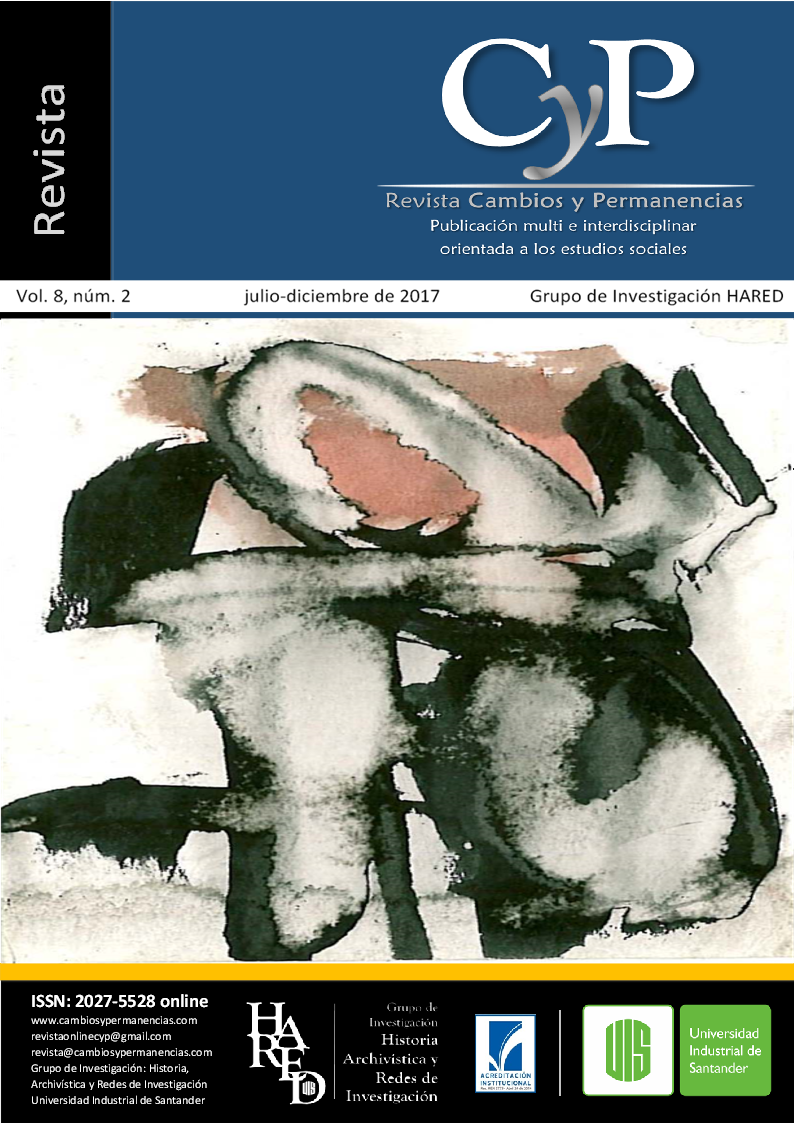Palabras clave
- Historia barrial,
- Violencia bipartidista,
- víctimas,
- historia oral,
- Barrio Nuevo Chile
Cómo citar
Resumen
La ponencia se realiza a partir de los testimonios de 10 habitantes del barrio Nuevo Chile, con relatos sobre las circunstancias previas a su llegada al Barrio, las cuales, en su inmensa mayoría, hacen referencia a cuatro grandes asuntos: ser víctimas de un sistema que no garantiza vivienda digna para todos, un modelo económico que obliga a migrar en búsqueda de un mejor futuro en la ciudad, ser víctimas de la Violencia bipartidista y, ser acosados por su militancia en el Partido Comunista. Se trata de considerar la reflexión desde los primeros pobladores y fundadores del barrio en una mirada que no se limita al barrio mismo sino que considera las dinámicas tanto de la ciudad, como de los efectos de la violencia política que vive el país desde comienzos del siglo XX. La investigación sobre el barrio Nuevo Chile contempla otros testimonios, pero no son incluidos en la presente versión ya que se destaca, en lo fundamental, la victimización que sufrieron antes de llegar a Bogotá.
El barrio Nuevo Chile fue resultado de la acción directa de las comunidades a partir del 14 de febrero de 1971, en lo que inicialmente se denominó una invasión realizada por 540 familias y que hoy se resignifica como una ´recuperación´, en un proceso organizado por la Central Nacional Provivienda (Cenaprov o Provivienda), bajo la influencia del Partido Comunista (PCC).
Descargas
Referencias
Comisión histórica del conflicto y sus víctimas (2015) Contribución al entendimiento del conflicto armado en Colombia. Bogotá, Colombia: Ediciones Desde Abajo
Oviedo, Álvaro (2012) Memoria y luchas urbanas. Por el derecho a una vida digna. Historia de vida de Mario Upegui. Bogotá, Colombia: Ed. Izquierda Viva.
Rodríguez Idárraga, Nicolás. (2008) Los vehículos de la memoria. Discursos morales durante la primera fase de la violencia (1946-1953). Bogotá, Colombia: Universidad de los Andes, Facultad de Ciencias Sociales, Departamento de Historia, CESO, Ediciones Uniandes.
Torres, Alfonso (1993). La ciudad en la sombra. Barrios y luchas populares en Bogotá 1950-1977. Bogotá, Colombia: Cinep.
Prensa
Arango Z., Carlos. (marzo 16 de 1978). Miguel Suárez murió como un héroe. Voz Proletaria, p. 10
Arango Z., Carlos. (marzo 2 de 1978), A pesar de la represión. Notable victoria en Yacopí. Gran avance. Voz Proletaria, p. 1, 4, 5
Denuncias sobre torturas en Yacopí. (marzo 9 de 1978). Voz Proletaria, p. 8
El padre Morlión, Dominicano belga habla sobre la lucha anticomunista. (10 diciembre 1952). El Tiempo, p. 3.
Santos invita a los empresarios italianos a “invertir en Colombia. (15 diciembre de 2016) Radionet. Recuperado de http://www.radiored.com.co/noticias/economia/santos-invita-a-empresarios-italianos-a-invertir-en-colombia/
Saúl Fajardo fue muerto a tiros en las puertas de la cárcel modelo, el martes. (5 de diciembre 1952) El Tiempo, p.1
Yepes L., José. Tortura en un barrio de Bogotá. (10 de febrero de 1976) El Espectador. P. 1 y 3C
Testimonios
Betancurt, José. (3 de febrero de 2008). Entrevistado por F. Castro.
Córdoba, Jesús “Chucho”. (24 febrero 2008). Entrevistado por J. Ortiz, F. Becerra, F. Castro.
Fernández, Rodulfo. (26 de enero de 2008). Entrevistado por F. Castro, J. Ortiz, F. Becerra.
Garay viuda de Victoria, Ana Rosa. “Lulú”. (10 de diciembre de 2011). Entrevistada por F. Castro, J. Prieto y C. Poveda.
Lara, Lucio. (2 de diciembre de 2012). Entrevistado por M. A. Vargas, F. Nieto y L. Torres.
Minotas, Carmen. (l 3 de febrero de 2008). Entrevistado por F. Castro y J. Ortiz.
Motta, Bernardino. 83 de febrero de 2008). Entrevistado por F. Castro, J. Ortiz y F. Becerra.
Pérez, Adela. (17 de julio de 2016). Entrevistado por F. Castro.
Pérez, Sonia. (8 de enero de 2012). Entrevistado por F. Castro y D. Daza.
Sánchez, Florentino. (14 de diciembre de 2008). Entrevistado por J. Ortiz y F. Castro.

